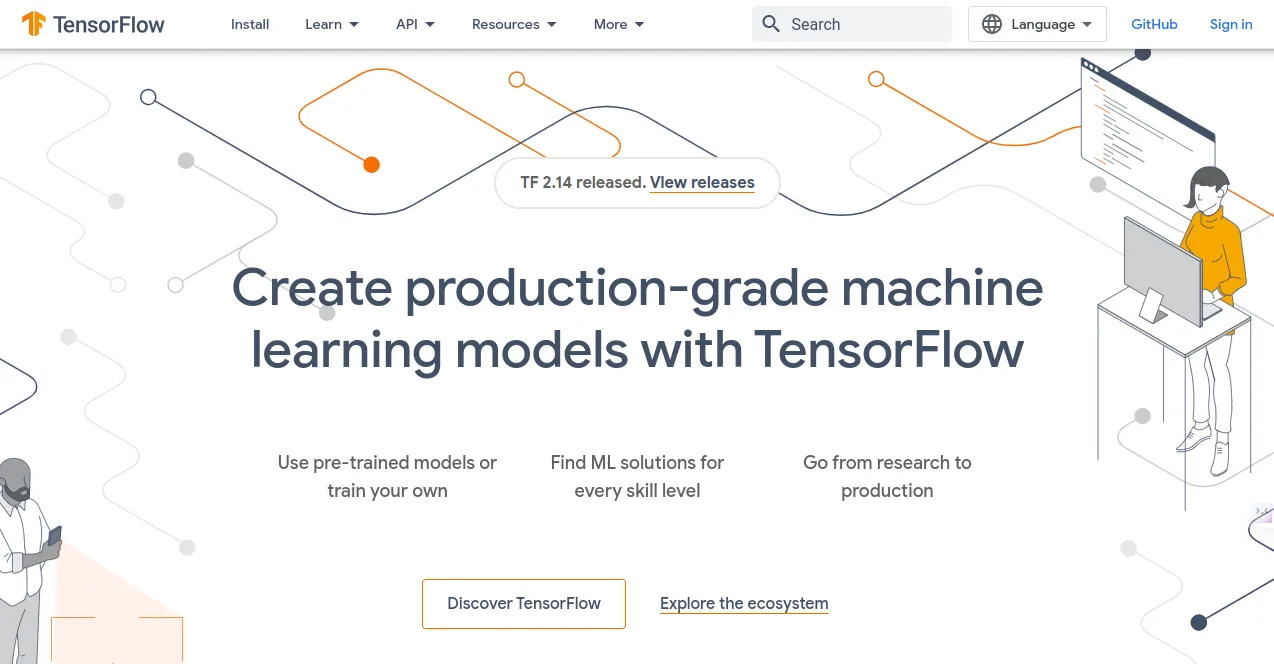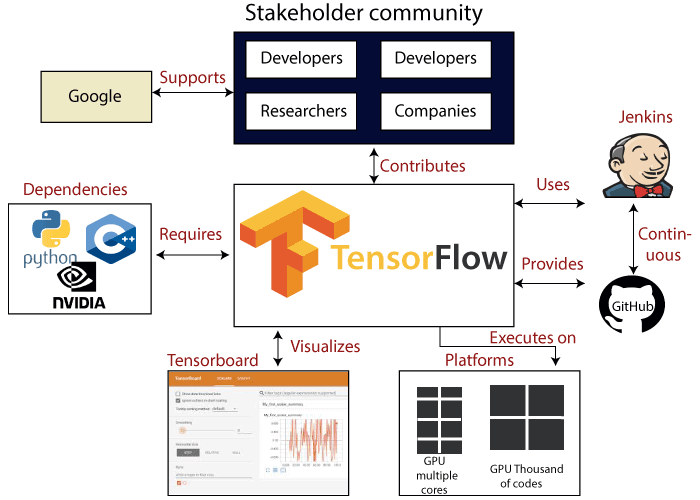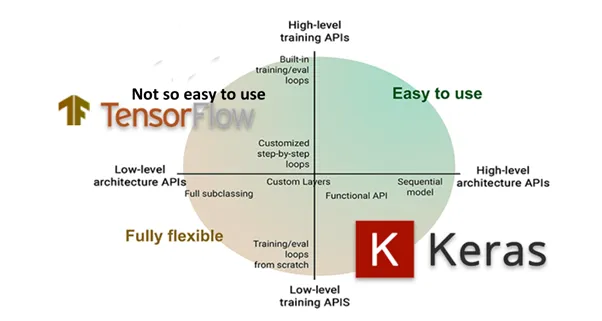Keras and TensorFlow are the two superstars of artificial intelligence that have transformed the field, but what distinguishes them? Join us as we explore the complexities of Keras and TensorFlow, understanding what makes them different and discovering their distinct strengths.
Did you know that Keras has been downloaded over 18 million times, whereas TensorFlow has over 2,000 GitHub contributors?
These figures alone demonstrate the popularity and significance of these frameworks.
So, whether you're a seasoned data scientist or just starting in the area of deep learning, buckle up as we dive into the intriguing world of Keras versus TensorFlow.
What is Keras?

To make deep learning available to everyone, Keras was created by François Chollet, a Google employee. Keras was born in 2015, swiftly rising to popularity in the AI world. It's the welcoming, accessible aspect that offers a deep learning environment. You don't have to be a coding genius to develop neural networks using Keras.
However, the functions of Keras doesn't end there. It provides a high-level API that abstracts away deep learning's complications. You have access to pre-built layers, activation features, and optimizers. This allows you to concentrate on creating the architecture for your model.
What is the greatest thing? You may explore and quickly prototype with Keras. Its adaptability and simplicity make it a haven for fans of AI. Examine the performance of various designs while adjusting hyperparameters.
Keras has made an impact in speech recognition, computer vision, and natural language processing, demonstrating its adaptability in a variety of fields. Keras is your dependable buddy, ready to make your deep learning experience smooth whether you're a beginner or a master.
So let's carry on with our research and learn more about Keras's distinctive advantages.
What is TensorFlow?

An intriguing universe in the field of deep learning, a tremendous powerhouse - TensorFlow. Think of TensorFlow's computation graph notion as the manual for your artificial intelligence (AI) projects.
You may effectively conduct computations across CPUs, GPUs, and even distributed systems by using nodes to represent mathematical operations and edges as the data flow channels.
TensorFlow is the ultimate AI toolset you can use to construct models with complex patterns and let your imagination run loose. It's like having a flexible canvas on which to paint intricate architectural designs and even add your special procedures and original optimization methods.
TensorFlow offers a deeper dig, providing you with fine-grained control and the capacity to write low-level code in languages like C++, in contrast to Keras, which gives a more user-friendly experience.
TensorFlow has provided several solutions, much like a multi-talented champion. It is the go-to solution for a variety of difficulties across sectors, making our planet smarter and more developed. From recognizing photographs to anticipating financial trends to even revolutionizing autonomous driving.
How does Keras work?

Let's explore Keras' architecture and parts, which may be seen as a well-organized toolkit for building and refining AI models. Layers and models are the two main characters at its heart.
Keras offers you the Sequential API and the Functional API as two cool approaches to creating your models. With the Sequential API, you can build gorgeous linear paintings by simply stacking your layers one on top of the other.
The Functional API, on the other hand, is more akin to creating a 3D sculpture. You may create models with various inputs and outputs and sophisticated architectures with shared layers because of the added freedom it gives.
Depending on your creative vision, you have a decision to make.
The process of creating and training your models with Keras is straightforward. Simply use the add() function to stack your layers, identifying each layer's type and parameters. Once your model is complete, you may refine it by compiling it, which is similar to assigning it a task.
You define the metrics (how it assesses itself), the optimizer (how it adapts and learns), and the loss function (how it monitors success).
How TensorFlow Works?

An efficient structure that leverages computational graphs is TensorFlow. Let's explore the show's leading star: There are three key parts of TensorFlow.
The graph organizes every mathematical action that goes into creating your AI model. The session is the next step. The real calculation takes place there. Tensors are the last category. They convey the data that our model analyses.
The real master, though, is the computational graph. You see, you create nodes for each operation, such as addition, multiplication, or even more complicated processes like convolutional layers for image processing, to form this network.
The actual miracle is that you can create complex neural networks using these methods. Once your composition is complete, you may play it by starting a session and carrying out the associated activities.
Suggested Reading:
Key Differences between Keras and TensorFlow

Let's examine the main contrasts between Keras and TensorFlow, beginning with their usability.
Ease of Use
- Keras: A User-Friendly Interface
With its reputation for being straightforward and user-friendly, Keras is your friendly guide in the field of deep learning. A high-level API provided by Keras is as simple to understand as a friendly chat. With just a few lines of code, neural networks may be constructed and trained simply like LEGO blocks.
It is the ideal partner for beginners making their initial forays into deep learning because of its simple syntax and modular architecture. So, Keras extends a warm welcome and stands ready to ease the experience with AI.
- TensorFlow: A Powerful and Flexible Framework
Let's next look into TensorFlow, which follows a different methodology. You may think of it as a flexible and under full-control AI workshop. TensorFlow, in contrast to Keras, provides a lower-level experience similar to that of a skilled artisan with high-quality tools.
With its complete toolbox, you can precisely construct and train even the most intricate neural networks. TensorFlow therefore provides a world of virtually endless opportunities in the field of deep learning if you're someone who demands fine-grained control or seeks to take on difficult AI jobs.
Backend Support
Keras and TensorFlow differ in their backend support. Given its versatility, Keras supports a variety of backends, including TensorFlow and Theano. Contrarily, TensorFlow features a specific backend that makes the development process simpler. Having a clear understanding of these differences will help you select the best tool for your deep learning projects.
- Keras: Multiple Backend Options
High-level neural network API Keras works well with TensorFlow, Theano, and CNTK, among other deep learning frameworks. This allows you to select the performing ensemble that best meets your requirements and interests, turning your deep learning experience into many options.
- TensorFlow: Native Backend
TensorFlow has a built-in backend of its own, encouraging a close-knit community inside the TensorFlow family. TensorFlow is the go-to option for companies looking to maximize their AI capabilities because of this special link, which enables users to make use of the entire range of TensorFlow's numerous features and optimizations.
Model Building
When constructing models, TensorFlow gives fine-grained control, similar to an artist with a blank canvas, whereas Keras offers simplicity with a stacking of layers analogous to LEGOs. Here, your AI vision comes to life.
- Keras: Simplified Model Construction
Your AI toolset is Keras. It offers a powerful magic wand that is made of pre-assembled layers similar to LEGO bricks. These layers may be easily combined, resulting in a unique neural network model that is suited to your requirements.
- TensorFlow: Low-Level Model Construction
AI architects have access to high-precision tools using TensorFlow. In contrast to Keras, TensorFlow provides a lower-level methodology that gives developers the freedom to build their models from scratch. It's like having complete control over the construction of bricks, like being a master builder.
This makes it possible to deeply customize and fine-tune your AI creations, enabling you to precisely mold them like a master craftsman molding a masterpiece.
Suggested Reading:
Conclusion
The universe of deep learning is TensorFlow. It gives you access to a variety of features and advantages. Its scalability and flexibility make it simple to design and deploy models across a range of platforms and devices.
TensorFlow is the best option for your machine-learning adventures since it works well with others and integrates with many libraries and tools without any issues. With its strong support for distributed computing, it's like having a team of specialists at your side.
TensorFlow has your back whether you're solving complicated issues or making use of parallel computing. Don't forget the turbo boost either; with GPU assistance, deep learning model training may be completed much more quickly and effectively, accelerating your AI journey.
As a whole, TensorFlow is an unbeatable option for all your deep learning endeavors because of its extensive infrastructure and vibrant community. It's like having a reliable friend at your side who is eager to realize all of your AI ambitions.


